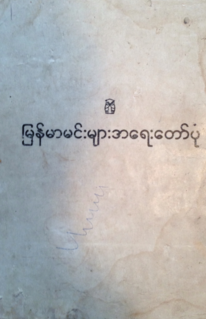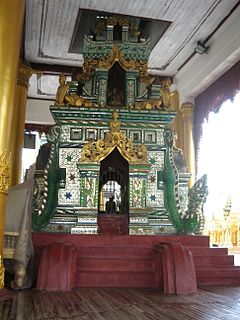
Inwa or Ava, located in Mandalay Region, Burma (Myanmar), is an ancient imperial capital of successive Burmese kingdoms from the 14th to 19th centuries. Throughout history, it was sacked and rebuilt numerous times. The capital city was finally abandoned after it was completely destroyed by a series of major earthquakes in March 1839. Though only a few traces of its former grandeur remain today, the former capital is a popular day-trip tourist destination from Mandalay.
Anaukpetlun was the sixth king of Taungoo Burma and was largely responsible for restoring the kingdom after it collapsed at the end of 16th century. In his 22-year reign from 1606-1628, Anaukpetlun completed the reunification efforts begun by his father, King Nyaungyan. Having inherited a partial kingdom comprising mainly Upper Burma and the Shan States from his father, Anaukpetlun went on to reconquer Lan Na in the east, and in the south, Lower Burma from rival Burmese factions and the Portuguese, as well as the Upper Tenasserim from the Ayutthaya Kingdom. The kingdom was known as the Restored Taungoo Kingdom or Nyaungyan Dynasty.

The Toungoo dynasty was the ruling dynasty of Burma (Myanmar) from the mid-16th century to 1752. Its early kings Tabinshwehti and Bayinnaung succeeded in reunifying the territories of the Pagan Kingdom for the first time since 1287 and in incorporating the Shan States for the first time. At its peak, the First Toungoo Empire also included Manipur, Chinese Shan States, Siam and Lan Xang. But the largest empire in the history of Southeast Asia collapsed in the 18 years following Bayinnaung's death in 1581.
Myint Aung was a Burmese film director and film actor. He was the father of famous actress Mo Mo Myint Aung.
Maha Thiha Thura is one of the most prestigious feudal era titles assumed by Burmese royalty or granted to highest ranking generals and ministers. The most famous person to wear the title is the Konbaung-era general who defeated Manchu Qing invasions of Burma (1765–1769) but the title may also mean:

The Third Anglo-Burmese War, also known as the Third Burma War, was a conflict that took place during 7–29 November 1885, with sporadic resistance and insurgency continuing into 1887. It was the final of three wars fought in the 19th century between the Burmese and the British. The war saw the loss of sovereignty of an independent Burma under the Konbaung dynasty, whose rule had already been reduced to the territory known as Upper Burma, the region of Lower Burma having been annexed by the British in 1853, as a result of the Second Anglo-Burmese War.
Nyaungyan Min was king of the Toungoo Dynasty of Burma (Myanmar) from 1599 to 1605. He is also referred to as the founder of the Restored Toungoo Dynasty or Nyaungyan Dynasty for starting the reunification process following the collapse of the Toungoo Empire.
Saw Hnit was a viceroy of Pagan (Bagan) from 1297 to 1325 under the suzerain of Myinsaing Kingdom in central Burma (Myanmar). He was a son of the Mongol vassal king Kyawswa, and a grandson of Narathihapate, the last sovereign king of Pagan dynasty. Saw Hnit succeeded as "king" after his father was forced to abdicate the throne by the three brothers of Myinsaing in December 1297.
Thihathura or Thiha Thura was a Burmese royal title. Today, Thiha Thura is the second highest military decoration awarded by the Burmese military.

Nyaungyan Mintaya Ayedawbon is an 18th-century Burmese chronicle of King Nyaungyan of Toungoo Dynasty.
Min Letya was governor of Ava (Inwa) from 1584 to 1586 during the reign of King Nanda of Toungoo Dynasty of Burma (Myanmar). Min Letya was the only son of King Tabinshwehti mentioned in the Burmese chronicles.
Thiri Maha Dhamma Yaza Dipadi Dewi was the chief queen consort of King Nyaungyan of Toungoo Dynasty of Burma (Myanmar). She married her half-brother Nyaungyan on 25 February 1577. Note that her personal name is sometimes reported as "Khin Hpone Myat".
Khin Pyezon was a minor queen of King Bayinnaung of Toungoo Dynasty. She was the mother of King Nyaungyan.
Thado Dhamma Yaza III was viceroy of Prome (Pyay) from 1589 to 1595, and self-styled king of Prome from 1595 to 1597. Hnaung was initially a loyal vassal of his father King Nanda until 1594 when he openly clashed with his brother Crown Prince Minye Kyawswa. Hnaung revolted in 1595 during the Siamese siege of Pegu (Bago). His revolt started a string of other revolts by the major vassal states of the Toungoo Empire in the next two years. His attempts to take over territories beyond Prome's traditional vassals in the present-day Magwe Region were unsuccessful. The self-proclaimed king was assassinated by Yan Naing, one of his trusted advisers, on the eve of his planned invasion of Upper Burma in 1597.

Glass mosaic is a traditional Burmese mosaic made with pieces of glass, used to embellish decorative art, structures, and furniture. Glass mosaic is typically divided into two subcategories, hman gyan si (မှန်ကြမ်းစီ) and hman nu si (မှန်နုစီ). The former is typically used to decorate the walls and ceilings of pagodas, while the latter is used to embellish furniture and accessories. The art form originated in the 1500s during the Nyaungyan era. Glass mosaic is often studded with gems and semi-precious stones.
Saw Pale was a Burmese royal name.
Maniket, from Pali: Maṇikakkha (မဏိကက္ခ), is considered to be the earliest extant play in modern-day Myanmar, complete with dialogue, song lyrics, and stage directions. The storyline of Manikhet is based on the Sattadhanu Jataka, the 20th story in the Paññāsa Jātaka, a non-canonical collection of stories of the Buddha's past lives from Lan Na.

Padethayaza, also spelt Padesarājā, was a minister who served the last three monarchs at the Nyaungyan court, and was a prominent writer and poet. He is known for composing pyo, lyrical poems based on the Jataka tales. While he wrote traditional works pertaining to Buddhism, he was also known for expanding his repertoire, drawing from Hindu tales, apocryphal birth stories of the Buddha, current events such as the arrival of Thai envoys to the Burmese court, and village life for peasants. After the demise of the Nyaungyan court in 1754, Padethayaza was captured and taken to Bago Region.
Aung Zabu Forest Monastery, commonly known as Japan Paya is a Buddhist monastery (kyaung) in Yegya village, Hmawbi Township, Yangon Region, Myanmar (Burma).









